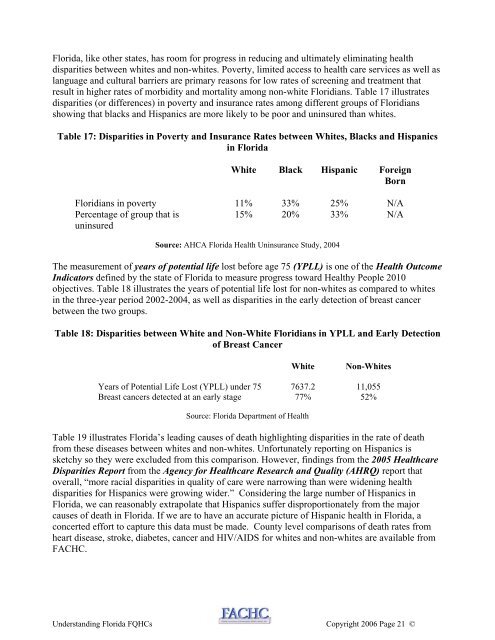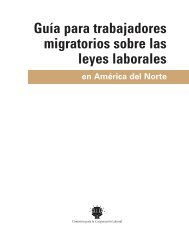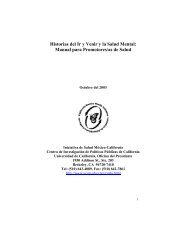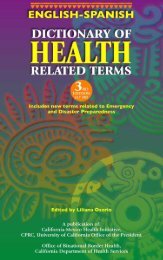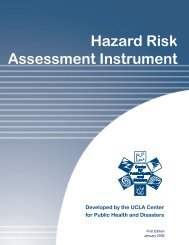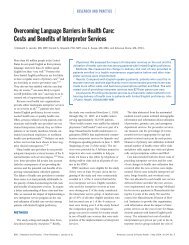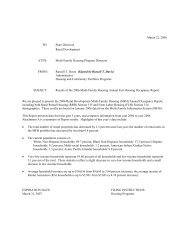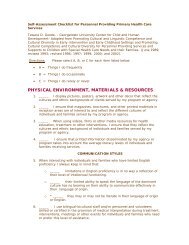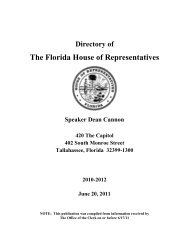Guide to Understanding Florida's FQHCs and 330 Expansion ...
Guide to Understanding Florida's FQHCs and 330 Expansion ...
Guide to Understanding Florida's FQHCs and 330 Expansion ...
Create successful ePaper yourself
Turn your PDF publications into a flip-book with our unique Google optimized e-Paper software.
Florida, like other states, has room for progress in reducing <strong>and</strong> ultimately eliminating health<br />
disparities between whites <strong>and</strong> non-whites. Poverty, limited access <strong>to</strong> health care services as well as<br />
language <strong>and</strong> cultural barriers are primary reasons for low rates of screening <strong>and</strong> treatment that<br />
result in higher rates of morbidity <strong>and</strong> mortality among non-white Floridians. Table 17 illustrates<br />
disparities (or differences) in poverty <strong>and</strong> insurance rates among different groups of Floridians<br />
showing that blacks <strong>and</strong> Hispanics are more likely <strong>to</strong> be poor <strong>and</strong> uninsured than whites.<br />
Table 17: Disparities in Poverty <strong>and</strong> Insurance Rates between Whites, Blacks <strong>and</strong> Hispanics<br />
in Florida<br />
White Black Hispanic Foreign<br />
Born<br />
Floridians in poverty 11% 33% 25% N/A<br />
Percentage of group that is<br />
15% 20% 33% N/A<br />
uninsured<br />
Source: AHCA Florida Health Uninsurance Study, 2004<br />
The measurement of years of potential life lost before age 75 (YPLL) is one of the Health Outcome<br />
Indica<strong>to</strong>rs defined by the state of Florida <strong>to</strong> measure progress <strong>to</strong>ward Healthy People 2010<br />
objectives. Table 18 illustrates the years of potential life lost for non-whites as compared <strong>to</strong> whites<br />
in the three-year period 2002-2004, as well as disparities in the early detection of breast cancer<br />
between the two groups.<br />
Table 18: Disparities between White <strong>and</strong> Non-White Floridians in YPLL <strong>and</strong> Early Detection<br />
of Breast Cancer<br />
White<br />
Non-Whites<br />
Years of Potential Life Lost (YPLL) under 75 7637.2 11,055<br />
Breast cancers detected at an early stage 77% 52%<br />
Source: Florida Department of Health<br />
Table 19 illustrates Florida’s leading causes of death highlighting disparities in the rate of death<br />
from these diseases between whites <strong>and</strong> non-whites. Unfortunately reporting on Hispanics is<br />
sketchy so they were excluded from this comparison. However, findings from the 2005 Healthcare<br />
Disparities Report from the Agency for Healthcare Research <strong>and</strong> Quality (AHRQ) report that<br />
overall, “more racial disparities in quality of care were narrowing than were widening health<br />
disparities for Hispanics were growing wider.” Considering the large number of Hispanics in<br />
Florida, we can reasonably extrapolate that Hispanics suffer disproportionately from the major<br />
causes of death in Florida. If we are <strong>to</strong> have an accurate picture of Hispanic health in Florida, a<br />
concerted effort <strong>to</strong> capture this data must be made. County level comparisons of death rates from<br />
heart disease, stroke, diabetes, cancer <strong>and</strong> HIV/AIDS for whites <strong>and</strong> non-whites are available from<br />
FACHC.<br />
<strong>Underst<strong>and</strong>ing</strong> Florida <strong>FQHCs</strong> Copyright 2006 Page 21 ©


